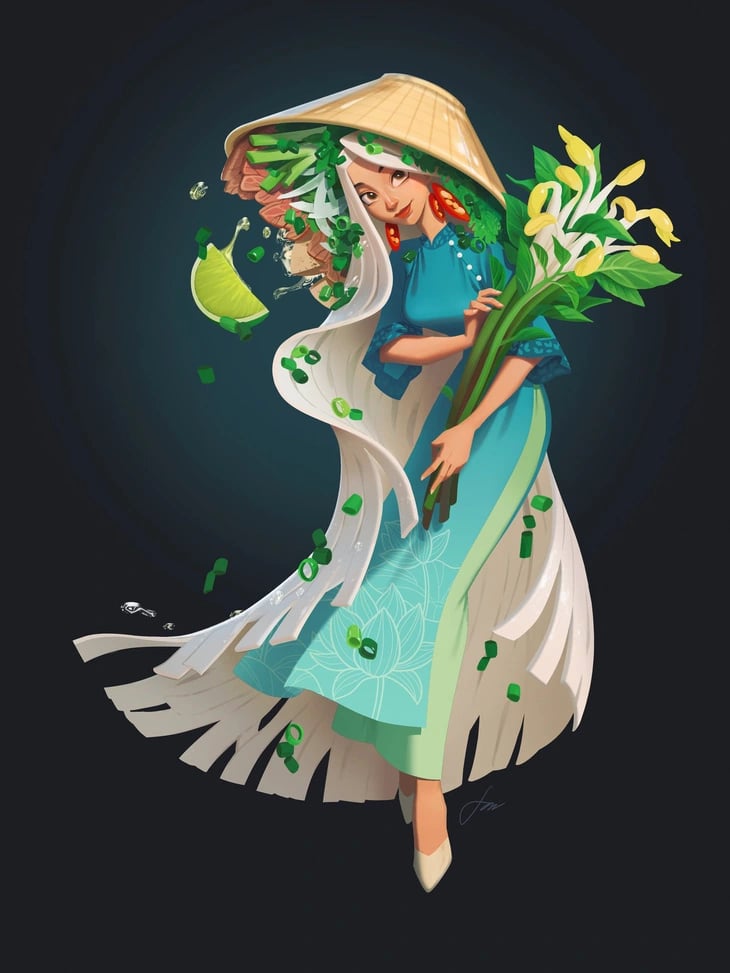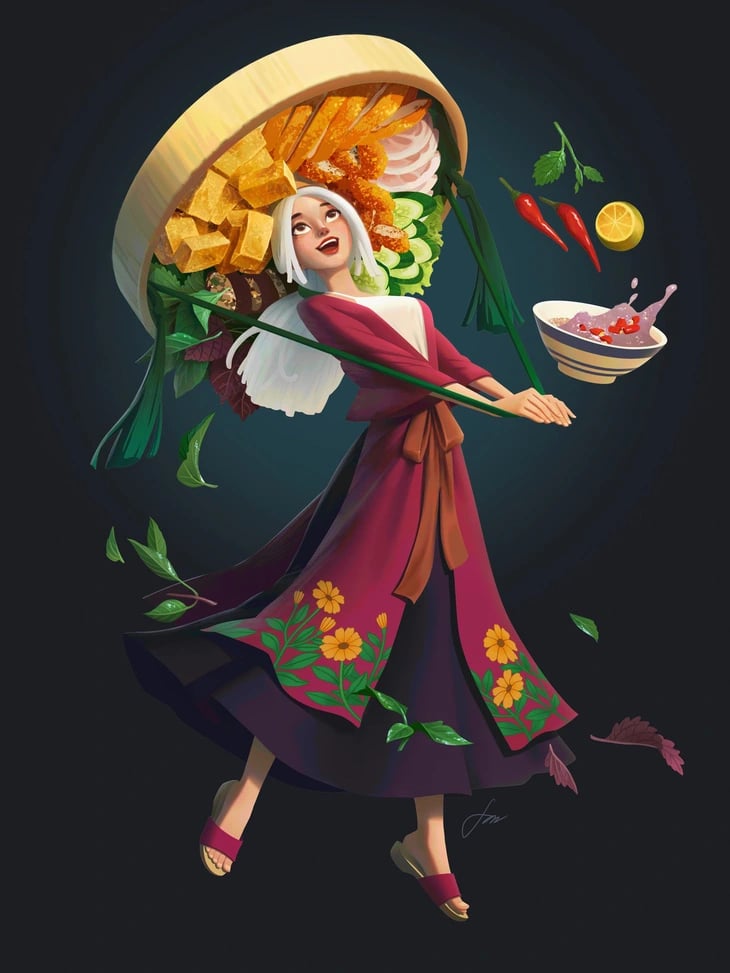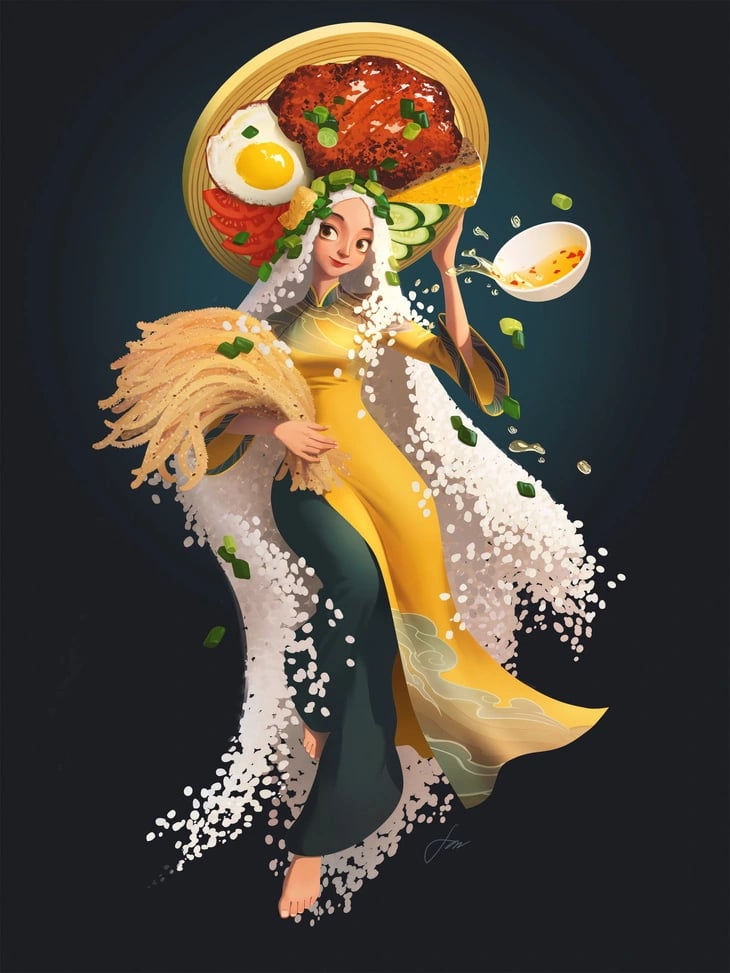Paintings depicting fairies inspired by Vietnamese typical dishes, such as pho (Vietnamese noodle soup), com tam (broken rice), and bun dau mam tom (rice vermicelli noodles with fried tofu and shrimp paste), by a Vietnamese artist have bewitched netizens.
The author of the paintings–Nguyen Hoang Son, a 29-year-old artist in Ho Chi Minh City, told Tuoi Tre (Youth) newspaper that he wanted to use images of Vietnamese food as a source of inspiration for his paintings for a long time as they are close and easy to find.
He recently had a job related to the design of characters based on food, so he thought of Vietnamese food, Son said.
It takes him two to three weeks to complete a painting.
He shared that he used no special techniques but tried to describe dishes.
He chose colors based on his emotions to create clothes for the fairies.
 |
| The beautiful ‘pho’ fairy. Photo: Supplied |
For instance, the ‘pho’ fairy is soft, flowing, and gentle.
Meanwhile, the ‘com tam’ fairy was made beautifully and added some details so that the viewers can easily realize it.
He found the ‘com tam’ fairy was the most difficult painting. Son wanted to paint costumes of people in the southern region but ao ba ba (a traditional garment of people in southern Vietnam) and non la (Vietnam's traditional conical hat) have been featured in paintings earlier and they do not match com tam.
“I kept thinking and decided to use ao dai (Vietnam's traditional long gown). I also painted man (turban) as it looks like a dish.
“Painting rice was not hard. I also tried to paint leaves.
“I thought the most difficult step was making the painting look delicious and eye-catching so that viewers will crave it.”
 |
| A basket of bun dau mam tom’ is also ‘non quai thao’ (Vietnamese flat palm hat) of the fairy. Photo: Supplied |
Son revealed that he bought a bowl of pho as a material for his painting before drawing the ‘pho’ dairy.
He later ate this bowl of pho but found that he forgot something, so he had to buy another bowl of pho.
He loves the ‘pho’ painting the most as he painted it naturally and comfortably.
To make paintings of dishes lively, artists need to make themselves crave for the dishes first, then adding details, Son shared.
His secret is to adhere to the topic and then develop ideas.
“When everything happens naturally, we find it comfortable to look at and easily recognize the dishes and characters,” Son said.
![Vietnam’s ‘banh mi’ [Vietnamese bread] in the artist’s painting. Photo: Supplied](https://static.tuoitrenews.vn/ttnew/r/2024/07/05/4-1720162874.jpg) |
| Vietnam’s ‘banh mi’ [Vietnamese baguette] in the artist’s painting. Photo: Supplied |
When the paintings were uploaded to social media, local netizens praised the special paintings and provided information about ways to enjoy the dishes in different regions in Vietnam.
As a case in point, pho in Hanoi is not served with bean sprouts and herbs.
Some regions do not use mam tom (shrimp paste) but nuoc mam (fish sauce) with bun dau.
Son added that “I am fond of Vietnamese cuisine. Wherever I go, I always remember family meals.
 |
| The author of the paintings. Photo: Supplied |
“I plan to paint bun bo Hue [Hue-style beef noodles] as I love this dish,” the artist noted.
He does not intend to paint all Vietnamese dishes but will try to paint as many as possible.
He also plans to do paintings that personify architecture and landscapes in Vietnam and dishes of other countries in the world.
Like us on Facebook or follow us on Twitter to get the latest news about Vietnam!



























